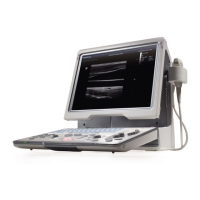5-6 Image Optimization
Adjust through the [iClear] item in the menu;
The system provides 5 levels of iClear effects adjustment, off represents no
iClear is turned on, and the bigger the value the stronger the effect.
The bigger the value the clearer the profile of the image.
Smooth
Rejects image noise and makes images smooth.
Adjust through the [Smooth] item in the menu;
The system provides 4 levels of smooth function, the bigger the value the
higher the smooth adjustment.
Persistence
This function is used to superimpose and average adjacent B images, so as to
optimize the image and remove noises.
Adjust through the [Persistence] item in the menu;
The system provides 8 level of frame average adjustment, the bigger the
value the stronger the effect.
Persistence can remove image noise to make details to be clearer.
Persistence increase may lead to signal missing.
Rotation/ Invert
This function provides a better observation for image display.
To invert the image horizontally or vertically.
Click [L/R Flip] or [U/D Flip] in the menu to invert the image.
Rotate the image through the [Rotation] item in the menu.
Image can be rotated by the manners in angle of 0°, 90°, 180°, 270°.
When the image is rotated in the angle of 90° or 270°, the depth scale is
displayed on the upper part of the screen.
When you flip or rotate an image, the “M” mark will change its position on the screen; the M
mark is located in the upper left corner of the imaging area by default.
The function is available in real-time imaging, freeze or cine review status.
iBeam
This function is used to superimpose and average images of different steer
angles to obtain image optimization.
Adjust through the [iBeam] item in the menu;
Off: no iBeam
On: maximum iBeam optimization
Images after iBeam processing can be optimized with less spot noise and
higher resolution, so that more details for the structure are revealed.
iBeam is not available when trapezoid function is turned on.

